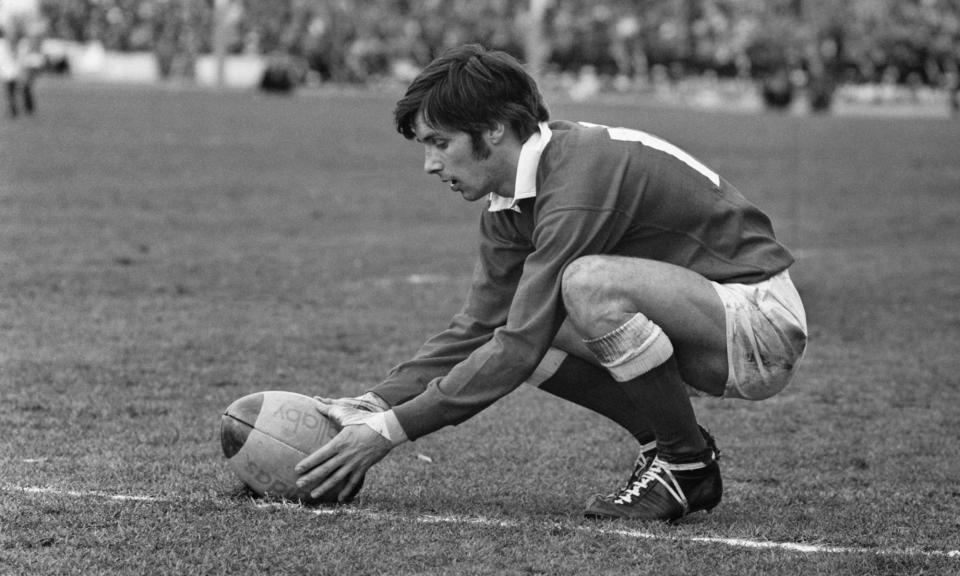Farewell Barry John, the fly-half who played rugby from another world

What sets the best sporting heroes apart is the way they make you feel. Which is why, when the final whistle arrives, there is such a deep and lasting sense of communal loss. Over and above his status as one of the greatest fly-halves to play rugby union and an enduring Welsh icon, the late Barry John will forever be the twinkling star of millions of youthful imaginations.
For better or worse the “King”, as they called him, played rugby from another dimension. He glided rather than ran and preferred to feint and tease rather than bump or smash. He was a clever kicker as well but, if circumstances allowed, his game was about spatial awareness, intelligence, evasion and angles rather than blunt‑edged orthodoxy. At his best he dealt in poetry rather than prose, an artful dodger in a world of leaden‑footed roundheads.
And, as with his fellow recently departed Welsh legends JPR Williams, Phil Bennett and John Dawes, he helped to give an entire nation an identity of which they could be proud. Not only did they win titles and grand slams but the way they sought to play set them thrillingly apart. Following the success of the 1971 British & Irish Lions tour, still the sole series-winning Lions expedition in New Zealand, their legendary standing was assured.
It was not all fun and frolics. At the height of his fame, in addition to the famous example of the overawed bank employee in Rhyl who curtseyed to him, John was waiting to cross Queen Street in Cardiff. As he stood there he was spotted by the driver of a nearby car who jumped out, leaving the engine running, to come and shake his hand. Soon enough others started to do the same, causing a traffic jam right back down the street.
Such levels of attention, in the end, proved too much and the King walked away from the game at the tender age of 27. In certain respects he was as much south Wales’s answer to Elvis Presley as his compatriot Tom Jones. One swivel of the hips on a high-profile stage and he could electrify any occasion just like that. Dealing with the adulation, and breaking free of its relentless tentacles, proved far harder.
His playing legacy, though, remains unshakeable. And, like it or not, it leaves modern rugby union with an ever trickier circle to square. On the hand it is desperate to retain the all‑shapes‑and‑sizes uniqueness, humour and rich heritage that continue to make it so appealing for many. And yet, as anyone who saw the weekend’s Six Nations games will have recognised, the players are involved in a sport that looks substantially different to what it did even 10 years ago let alone 50.
Not better or worse, necessarily, but different, both structurally and aesthetically. While there are still would-be creative magicians out there such as Scotland’s Finn Russell or, potentially, Wales’s Ioan Lloyd, the amount of time and space in which they have to work is now minimal. Gliding, hip-swaying, lightweight No 10s, consequently, have mostly gone the same way as prog rock and old-fashioned sweet shops.
Largely gone, too, are the days when teams would routinely take a chance to run from deep in their own half. As the former Wales coach Clive Rowlands observed, no one kicked high balls straight down Wales’s throat in their heyday unless they had a death wish: “In the seventies, if that happened, the first thing Barry John would say was: ‘Thank you. Now try to stop us.’”
Aggressive blitz defences, fitter kick chasers, prescriptive coaching, bigger athletes, protracted scrums, endless five‑metre lineout mauls, the death of rucking, brain injury fears ... take your pick from some of the factors that have made rugby, for many, a less beautiful game. We are not talking “jumpers for goalposts” nostalgia here, but more the relative predictability of how even the best sides attack, defend and operate more generally. Off‑the‑cuff intuition is frowned upon, on the grounds the other 14 players on the team will not know where to go. Data analysis in rugby is now so in-depth they can probably even tell you what type of aftershave a certain referee prefers. Not so long ago they would have been more liable to drink it.
The doyen of Welsh-based sportswriters, Peter Jackson, reported in the Daily Mail this week that John was among those unconvinced by the modern game’s evolution. “It’s not a question of would I play now, but would I want to play? No, I wouldn’t. It used to be a game you played to find space and run into it. Now they look for people to run into.” Or as the late David Duckham, another much-loved 1971 Lion, told me a couple of years ago: “We’d try and beat the man every time. Today’s players, backs or forwards, just plough straight into them.”
And, unfair comparison or not, how many of the Welsh team due to play England at Twickenham on Saturday will be causing traffic jams in Cardiff this week? Wales is still capable of producing culturally significant, respected national icons such as Alun Wyn Jones but the death of Barry John, as with JPR and Benny et al, is yet another grievous blow for sporting romantics everywhere.
Maybe everyone just has to accept the simple reality. Times have changed irrevocably and there is limited value in endlessly clinging to a sepia‑tinted past that was itself far from perfect. Some players, though, would have been special in any era and, as long as Welsh rugby exists, certain names will always resonate. The “King” may be dead but what he meant to people will never grow old.
This is an extract taken from our weekly rugby union email, the Breakdown. To sign up, just visit this page and follow the instructions.

